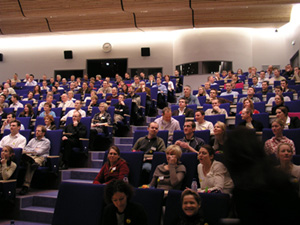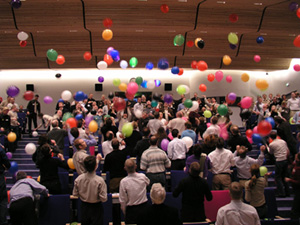DEVELOPING C,R,E,8,N,G!™ COMMUNITIES
THROUGHOUT YOUR WORKPLACE




Developing Cre8ng Communities and S.P.R.E.A.D.ng Creative Thinking throughout entire organizations from the front and back doors to the top floor.
Everyone is born with vast capacities to be creative.
Yet ALL cultures tend to cause people to conform and focus on "conventional thinking" rather than creative thinking in their workplaces,
EXCEPT when there is an emergency, life or death situations.
Then some to many people will use their...
HIDDEN, ASSUMED LOST, NOT USED or UNDEVELOPED CREATIVE THINKING ABILITIES to solve problems.
WHY WAIT? WHY GAMBLE?
Study the basic C,R,E,8,N,G!™ PROCESS (click here!!!)
Choosing your Challenge,
Reading Reaping information,
Examining what the problem really is,
Ideating "8" in a variety of ways,
Narrowing down many possible, potential, probable ideas into workable solutions,
Gathering resources, Generating your Plan and GO FOR IT !!!
Rather than waiting until a catastrophe why not start ENRICHING and EXPANDING the creativity of yourself and all your employees.
My colleagues and I through CRE8NG PEOPLE, PLACES & POSSIBLITIES can help you.
CP3 People, Places & Possiblities Colleagues
Developing Cre8ng Communities
in Your Workplace |
.
S.P.R.E.A.D.ng™ Cre8ng & Creative Thinking Throughout: Teams, Depts, Organizations
|
|
|
,
Keynote Addresses - Workshops - Training Programs - Consulting/Coaching

Every employee from the front door or shop floor to the top floor has much more creative potential than most organizations typically benefit from. Yes R&D, design, marketing and creative departments demonstrate their creativeness. For an organization to truly complete with its competitors it needs to have everyone using their creative thinking from the simple to the complex problems and from the daily to long range challenges.
Many companies periodically show SUPPORT of the creativeness of their employees but randomly, not consistent and rarely continuously over long periods of time.
Some companies hold PROMOTION campaigns to generate more creativity but they seldom last for very long and seldom are effective for more than a few days or possibly a week or two.
Other companies have RECOGNITION or REWARD Systems that usually last for a short time and fizzle without making much difference in the willingness of the employees to generate ideas and solve problems on their jobs.
Occasionally managers ENCOURAGE some of their employees to be deliberately creative but typically not for long nor with enough or all their employees.
People in the normally seen as CREATIVE AREAS are expected to APPLY creative thinking but uncommonly not throughout the entire organization.
On rare occasions and seldom more than randomly do organizations implement on-going DEVELOPMENT PLANS or PROGRAMS for increasing and enriching existing creative thinking skills, traits, abilities, tools and techniques.
HOW DO I AND OUR CP3 TEAMS KNOW THESE THINGS TO BE TRUE?
One.
I have been studying companies and organizations from the outside and from the inside when I have worked with their employees since 1976 (3200 presentations, workshops, seminars, training programs).
CP3 colleagues have been studying and learning from all their clients.
Two.
I have worked as a licensed architect in firms and had my own; as an interior designer, a graphics/signage designer, a freelance writer, a freelance cartoonist, a television newswriter and editor (WXYZ-TV, Channel 7, Detroit ABC Affiliate), a college professor and an international creativity consultant.
CP3 colleagues have worked as engineers, designers, researchers, business leaders and many other occupations
Three.
I have 5 college degrees out of 9 degrees I started. 3 in design. 1 a Masters in Guidance & Counseling of Gifted, Talented and Creative Individuals. 1 a doctorate in Educational Psychology focused on the teaching of creative thinking techniques in teams and workplaces.
CP3 colleagues bring their many varied degrees and their extensive professional training experiences.
Four.
All of the CP3 colleagues from around the world have extensive educations, training, and professional backgrounds working with companies, organizations, associations and / or governmental agencies around the globe.
How may I or teams of my colleagues at CP3 - Cre8ng People, Places & Possibilities from around the globe help you, your team, your department, your organization become far more creative and more successful?

Here is a description of a beginning program....
DEVELOPING CRE8NG COMMUNITIES IN YOUR WORKPLACE
4 to 5 day program - - from a gathering of individuals to total team involvement and commitment
(primary program consisting of leading, communicating, teaming, conflict resolution and creative thinking modules)
Scan down for complete outline of 4 to 5 day program
The main objective of all my programs, speeches, consulting and products is to help my clients S.P.R.E.A.D. Cr.e.8.n.g.™ and Creative Thinking throughout their entire organizations from an individual employee to teams to departments to ALL EMPLOYEES so that they can begin to develop C.r.e.8.n.g.™ Communities in their companies and agencies.
The S.P.R.E.A.D.ng acronym stands for 6 inter-related groups of things that we can all do to develop C.r.e.8.n.g.™ Communities in our organizations.
SUPPORTng,
PROMOTEng,
RECOGNIZEng,
ENCOURAGEng,
APPLYng and
DEVELOPng
This I do through the integration of skills of
_____________________________________________________________________________________________
These represent six basic needs in all workplaces, today and tomorrow.
Cre8ng™ Progressively -- Our greatest natural talent lies in our creative thinking abilities. Too often we squelch them internally and externally daily
. We need to support, promote, recognize, encourage, apply and develop the creative thinking and creativeness of everyone from the front door to the top floor.
Coordinating Productively -- We need people who can productively coordinate the work of others at all levels of our private, public and volunteer organizations. We need to develop coordinating skills and to help people discover their most productive coordinating style(s).
Communicating Thoroughly -- Communicating requires active and dynamic involvement of everyone. It requires that we S.T.I.R.™ things up. We need to SHOW what we mean. TELL what we want understood. INVOLVE everyone. REACH all people, whether speaking one-on-one or in front of large audiences.
Collaborating Successfully -- As Human Beings our greatest capacity is our ability to become highly successful teams when we truly need to. In today's workplace we need to learn to develop what is intrinsic to us nearly every working day and not take it for granted.
Conflict Resolution and Negotiation Skills
Connecting...reaching out and encouraging people to reach back so that you truly get to know each other
______________________________________________
Cre8ng™ People, Places & Possibilities Programs
Each of my Programs & Presentations are customized or specifically designed to further develop YOUR workplace into a.... Cre8ng Place.
All Programs & Presentations will increase YOUR people's skills of...
- Supporting, Promoting, Recognizing, Encouraging, Applying and Developing the Creative Thinking and Creativeness of yourself and ALL other Employees and people you work with: clients, customers, vendors, suppliers.
- Coordinating the work of others while teaching them to manage themselves and lead others.
- Communicating from one-on-one to meetings to large scale meetings and presentations.
- Collaborating the efforts of many as one.
My focus since 1984 has been to help people become:
- creative and productive (efficient and effective) problem solvers from ideas to successful implementation
- coordinators / leaders
- communicators
- collaborators / team members or team leaders

.
DEVELOPING CRE8NG COMMUNITIES THROUGHOUT YOUR WORKPLACE
Content Outline (4 to 5 day program)
Developing description
continued term description
RAB bio
Everyone a Leader in the 21st
Leader with a little "l"
How would you describe leader manager boss
Organizational Structure Comparison
Leadership is an Art…Max de Pree
Lead Follow or Get Out of the Way Jim Lundy
The Welch Way by Jeffrey A. Krames
Mind of a Manager, Soul of a Leader Craig R. Hickman
Leadership When the Heat's On Cox & Hoover
Collection of Leader Traits/Skills
12 most common traits
Developing a Leading Skill Training Program
Desired Traits of Leaders….study
How Leaders Make Decisions
MD Preferred Thinking Styles…think/lrn/comm/probsolv
How You Think/Learn/Solve Problems/Communicate
Meditative (M)
Intuitive (I)
Negotiative (N)
Directive (D)
12 cornerstones of Productive & Valuable Leading
Leadership Styles & Decision Making
Study & review questions
Is What I Think I Said What They….
How do you Communicate?
How we Communicate…6Ps of Powerful Communication
The Learning Pyramid
causes of mis-communication
communication modification tips
characteristics of MIND Design's
Basic Communication Styles
ABCs of Communication
ABCs of Communication - worksheet
How to improve listening skills
non-verbal communication
improving your listening skills - MIND Design
Study & review questions
How to improve listening skills-answer sheet
Conflict - a Tool or a Curse
Daily Conflict Example
Conflict Case Study
Kinds of Conflict
Dealing with Conflict
Negotiation (Conflict) Styles exercise
Conflict Resolution Styles instrument - page 1
Conflict Resolution Styles instrument - page 2
Conflict Resolution Styles instrument - page 3
Conflict Resolution Styles instrument - scoring page
Tips for De-Escalating Conflict
What Conflict Means to Me - Based on the MIND Design
Conflict - division exercise plan
Reducing conflict requires
Study & review questions
Connecting "I May Love Humanity…."
Demographics of your department today
What motivates today's employees
What do employees want?
value systems
value systems - definitions
NEW motivating people based on values & MD scores
NEW - Motivating Page with Maslow
Why People Don't Do What They Are Suppose To!
Leading the Unleadable, Unmanageable & Unbossable
Groups or Teams
Do we only benefit from teams?
Teaming Styles Using MIND Designs
Characteristics of Successful Teamwork
Decades exercise-understanding changing populations
Training for Impact grid
Training for Impact - sample plan
Study & review questions
SPREADng Creative Thinking Organization
Breaking Crayons Produces Creativity-back of title page
Paradigm 2010
The 7 Levels of Change by Rolf Smith
What is Creative?
Are You a Crayon Breaker?
Tombstones & Trophies
Enrichable & Expandable Skills
Forced Relationships - divergent tool
PCP - Pluses/Concerns/Potentials - convergent tool
Problem Solving Tools for Leaders
Team Building Exercise review and summary
Solving Logic Puzzles
Change…Stress, Resistance Changes
Inventions that have changed lives

Home 500+ Broken Crayons
Broken Crayons  M.I.N.D. Design
M.I.N.D. Design 



 Alan's Virtual Bookstore
Alan's Virtual Bookstore
Articles Business Sites Cre8ng Resources  Wandering Alan Contact
Wandering Alan Contact



